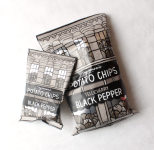Buying Better Anchovies
Ari on Anchovies, Part 3 of 3
Although you and I see them mostly in tins or jars, anchovies actually do start out swimming in the sea. This seemingly obvious fact always makes me wonder why people who generally like fish often profess such a strong distaste for anchovies.
Technically, anchovies are members of the species engraulidae. The Mediterranean is the traditional—and generally, still the best—source but these days they’re also fished off the coasts of Norway, Africa, Argentina, Southeast Asia, Chile and China. In my research I’ve seen various numbers of species and subspecies bandied about, anywhere from a sixteen to upwards of a hundred. Although I’ve never knowingly seen ‘em in person, a couple of my favorites by name are the Buccaneer anchovy (which apparently travels the furthest of all anchovies in the open ocean) and the Sabretooth anchovy (which as its name implies is said to have exceptionally—for an anchovy at least— large and sharp teeth). Regardless, the point is that there is no single “anchovy fish” to be found, but rather a series of aquatic relatives that are caught and cured using similar enough techniques to make them recognizable to us as members of the same fishy family.
So how can you spot a superior anchovy?
![]() Bigger is Better
Bigger is Better
In the anchovy world, no matter how well you use it, bigger is still considered to be better. How do you know which anchovies are bigger? Without sounding overly obtuse, usually you can tell just by looking. By definition, smaller tins will almost always contain smaller specimens—if all you do is buy a bigger tin you’ve already increased the odds of getting more flavorful fish. Similarly, the best anchovies are those packed in coarse salt, sold by the piece from five-kilo tins that are easily a foot in diameter, and the fish inside them can be nearly six inches in size.
![]() Look lively
Look lively
Once you open the tin you can do some visual assessment. Quite simply, better fish look better; a lively looking, rich-reddish, almost mahogany color (not unlike a nicely cured piece of prosciutto) and free of the blemishes that can be caused by sloppy handling or poor knife work as the fish are being processed. Inferior anchovies tend to be limp looking and lack the luster of superior specimens. If you’re unsure of brands you can get closer to higher quality by buying anchovies in glass jars so you can see what’s inside.
![]() Buy Filets Free From Bones
Buy Filets Free From Bones
You know how bad anchovy filets always seem to have that sort of unpleasant “crunchy” texture to them? This is because to keep costs down the producers don’t remove the bones. They just leave ‘em in and hope you don’t notice. The best anchovy filets have had the dozens of small bones removed with a tweezers. The filets are wiped clean with a cloth and then hand-packed with olive oil.
![]() A Smell is Worth a Thousand Words
A Smell is Worth a Thousand Words
“I want to know,” my friend Mabelle once demanded, “is there a difference in the aroma of a good anchovy and a bad anchovy?” I was actually a little embarrassed not to have already thought to check this myself. I went out and did a little homework. The embarrassingly obvious answer is, “Yes!” Having worked with fish professionally for two decades I should have known that—of course—while old, long out of the water offerings will smell something fierce (in all the worst ways), fresh fish really have hardly any aroma other than perhaps a nice, pleasant scent of the sea. And there’s no reason on earth—or I should say, in the ocean—that anchovies would be an exception to that rule.
The buyer’s problem of course is that you can’t very well open the tin and take a whiff while you’re standing in the store. I can tell you though that in the anchovy world there is a pretty direct correlation between price and product quality. Those $1.99 tins aren’t ever going to net you top-notch fish.




Zingerman’s Art for Sale